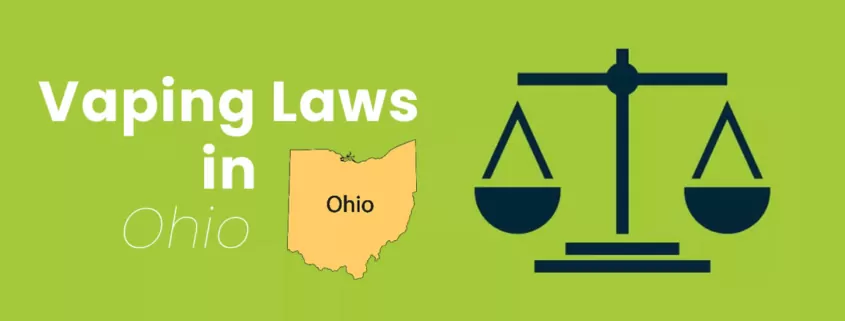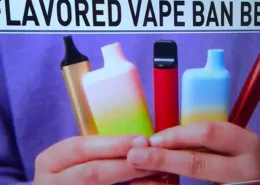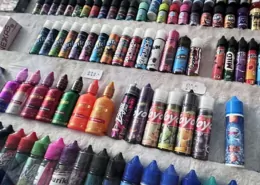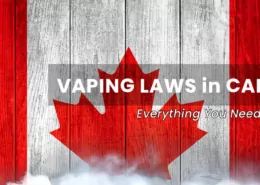Vaping Laws in Ohio 2025 – Is it Legal to Vape in Ohio
updated May / 2025
Comprehensive guide to Ohio’s vaping laws: statewide flavor ban, $1.20/ml tax, age 21 limit, public use restrictions, and local ordinances.
Ohio’s landscape for vaping products has seen significant shifts, with evolving laws and regulations impacting businesses and consumers alike. As of 2025, a complex framework of state statutes, new municipal powers, and federal oversight governs the sale, use, and taxation of electronic nicotine delivery systems (ENDS). Staying informed is crucial, whether you’re a vape business owner striving for compliance or a consumer seeking clarity. This guide provides an in-depth look at Ohio’s current vaping laws, incorporating recent legal developments and official sources to help you understand what’s permitted and what’s required.
Defining Vaping Products Under Ohio Law
To understand the regulations, it’s essential to know how Ohio law defines these products. According to Ohio’s Revised Code § 2927.02, an “electronic smoking device” includes any device designed to deliver aerosolized nicotine or other substances for inhalation. This broad definition covers e-cigarettes, vaporizers, vape pens, and their components.
Importantly, these devices are generally classified under the umbrella of “tobacco products.” Ohio defines tobacco products as any item containing nicotine intended for human consumption, irrespective of the delivery method. This classification is key because it subjects vaping products to many of the same stringent regulatory measures as traditional cigarettes, including restrictions on sales, taxation policies, and bans on public use.
The state also identifies “alternative nicotine products” as devices containing nicotine for ingestion through various means, excluding FDA-approved drugs or medical devices. This distinction ensures that recreational vaping products remain under tobacco control laws rather than pharmaceutical regulations.
Key Statewide Vaping Regulations in Ohio (2025)
Ohio has implemented a robust set of statewide rules governing the vaping market, focusing on public health, youth prevention, and product standards.

Age Restrictions and Sales Prohibitions
Aligning with federal law, the minimum legal age to purchase any tobacco or vaping product in Ohio is 21 . This is a cornerstone of Ohio’s efforts to curb youth access. Retailers bear significant responsibility in upholding this law:
- Mandatory Signage: Businesses selling these products must prominently display a sign stating it is illegal to sell to anyone under 21. The sign must use bold letters at least half an inch tall.
- Age Verification: Strict age verification protocols are required for all sales. For online or delivery sales, sellers must verify the buyer’s age, and if provided details seem fraudulent or mismatched, the sale must be refused.
- No Free Samples: Distributing free samples of vaping or tobacco products, even via coupons or promotional offers, is prohibited.
Violations of these sales restrictions can lead to significant penalties, including fines up to $1,000 per violation and, for repeat offenders, potential license revocation or even harsher punishments as lawmakers aim to curb teen vaping.
Statewide Flavor Ban and Product Standards
A major development in 2025 is Ohio’s enactment of a statewide ban on flavored vaping products, with exceptions only for tobacco and menthol flavors. This significant policy shift reflects Governor Mike DeWine’s long-standing advocacy for stricter controls, citing numerous studies linking flavored products to the initiation of vaping among adolescents.
Beyond flavors, all vaping products sold in Ohio must have received premarket authorization from the U.S. Food and Drug Administration (FDA). This federal requirement is enforced at the state and local levels, often through annual inspections conducted by local health departments. The aim is to ensure that products on the market have undergone some level of safety review.
Taxation and Licensing
Ohio has significantly increased its tax on vaping liquids. As of 2025, the state imposes an excise tax of $1.20 per milliliter of vaping liquid. This is a substantial rise from previous rates (like the $0.01 per vapor volume or 10 cents per milliliter mentioned in older regulations) and is intended as a fiscal disincentive to discourage consumption, particularly among price-sensitive younger individuals.
Retailers wishing to sell vaping products must obtain an annual vapor products distributor’s license from the Ohio Department of Taxation. The cost for this license is now $900 per location, and it must be renewed annually. Proceeds from licensing fees and taxes are often directed towards funding enforcement activities and public health initiatives aimed at tobacco and vape use prevention and cessation.
Smoke-free tobacco products, such as smokeless tobacco, are also taxed at 17% of the wholesale price, a consideration for retailers selling a range of tobacco and nicotine items.
Public Usage Restrictions
Ohio’s Smoke-Free Workplace Act was amended in 2021 to explicitly include vaping products. This means vaping is prohibited in all indoor public spaces and workplaces. This ban covers a wide array of locations, including:
- Restaurants and bars
- Offices and other places of employment
- Retail stores
- Recreational venues
Businesses are required to post “No Vaping” or “No Smoking/No Vaping” signage at all entrances and must remove ashtrays or other paraphernalia that might encourage use in restricted areas. An exemption exists for dedicated vape shops that derive over 80% of their revenue from tobacco and vape product sales, provided they strictly prohibit on-premises consumption by anyone under 21. Many Ohio colleges and universities have also implemented their own comprehensive smoke- and tobacco-free policies, banning vaping across their campuses.
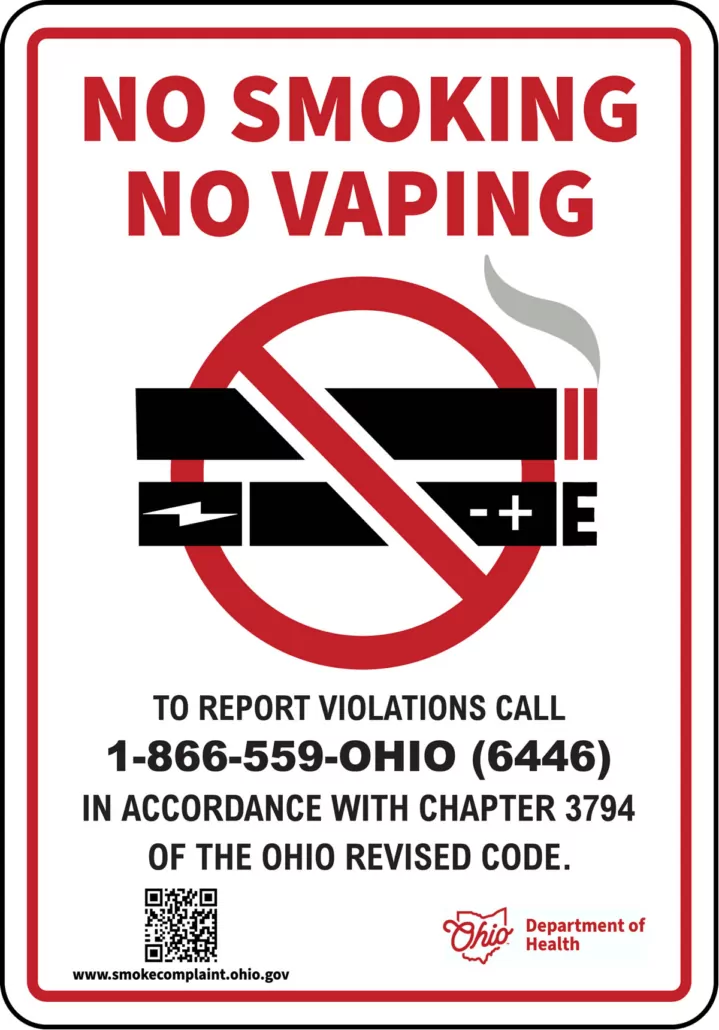
The Rise of Local Ordinances: Municipalities Take Action
A pivotal legal development occurred in May 2024 when a Franklin County judge ruled that a state law attempting to preempt (block) cities from enacting their own flavored tobacco sales bans was unconstitutional. This ruling has empowered Ohio municipalities to implement stricter local regulations than the state baseline.
Cleveland’s Comprehensive Approach
The city of Cleveland enacted robust ordinances in 2025 to address vaping prevalence, which local officials described as reaching “crisis” levels. Cleveland’s measures include:
- Zoning Restrictions: New vape shops cannot open within two miles of existing ones to prevent market oversaturation.
- Advertising Limits: Exterior advertising for vape shops is capped at 25% of window space, and interior product displays must occupy less than 10% of the retail area, aiming to reduce visual appeal to minors.
- No Marijuana Sales: Vape shops are prohibited from selling marijuana products, addressing concerns about co-mingling regulated substances.
Cleveland’s Health Department employs a dedicated team for enforcement, conducting biannual inspections and using undercover minor decoys. A $100,000 grant from a tobacco control nonprofit supports these local efforts.
Heath’s FDA Compliance Mandate
Following the Franklin County court decision, the city of Heath passed an ordinance in 2025 mandating that retailers sell exclusively FDA-authorized vaping products. This local law is enforced through collaborative inspections by the Licking County Health Department. Non-compliant businesses face fines up to $1,000 per violation and potential inventory confiscation. Heath’s approach leverages federal product evaluations to enhance local safety standards.
Other cities like Columbus and Bexley had previously attempted local flavor bans, and the 2024 court ruling affirmed their authority to do so, despite earlier state-level legislative efforts to prevent such local actions.
Federal Oversight: Manufacturing and Importing
While states and cities implement sales and use regulations, the manufacturing and initial introduction of vaping products into the market are primarily overseen by the FDA. Manufacturers must adhere to federal guidelines covering product standards, ingredient reporting, and proper labeling. Importers must also navigate strict federal import laws, ensuring products comply with all applicable regulations before entering the US market. The FDA, along with the U.S. Department of Justice, has formed a federal task force to curb the sale of unauthorized vaping products, signaling increased scrutiny. The Federal Trade Commission (FTC) also monitors advertising, recently issuing its third report on e-cigarette sales and advertising, emphasizing that health claims must be substantiated.
Enforcement and Penalties
Enforcement of Ohio’s vaping laws is a collaborative effort:
- State-Level: The Ohio Department of Health’s Smoke-Free Workplace Program investigates complaints about public vaping violations, with fines for individuals ($100) and businesses ($500-$2,000) . The Ohio Attorney General’s office also plays a role in tobacco enforcement, including targeting illegal sales to youth.
- Local Health Departments: As seen in Cleveland and Heath, local health departments are often on the front lines, conducting inspections for age verification, product compliance, and adherence to local ordinances.
- Penalties: Beyond fines, violations can lead to license suspensions, inventory confiscation, and mandatory educational programs for retailers. Persistently selling to minors or unauthorized products can result in more severe consequences.
The decentralized framework resulting from the Franklin County ruling, while empowering local action, also presents compliance challenges for businesses operating in multiple jurisdictions, as they must navigate a patchwork of varying local standards alongside statewide mandates.

ECIGATOR
Ecigator is one of the well-known vape brands spun off from FM Technology Co., Ltd, it’s an ISO-certified disposable vape manufacturer for OEMs, ODMs, and OBM since 2010. The founder team comes from top firms with more than 10 years of experience in the vaping industry and has devoted thousands of hours to providing users with a better and better experience.
Public Health Goals and Future Directions
Ohio’s evolving vaping policies attempt to strike a balance between preventing youth initiation and addiction, and potentially offering adult smokers less harmful alternatives to combustible cigarettes. The statewide flavor ban and increased taxation align with CDC recommendations aimed at curbing youth uptake. Requiring FDA authorization for products aims to remove unregulated and potentially unsafe items from the market.
However, disparities in local enforcement capabilities could create “regulatory havens” in some areas, potentially undermining statewide public health objectives. Future legislative and policy discussions in Ohio may focus on:
- Standardizing certain aspects of municipal ordinances to reduce compliance complexity for businesses.
- Expanding access to smoking and vaping cessation programs, potentially funded by the increased tax revenue.
- Addressing emerging nicotine products, such as oral nicotine pouches, and new synthetic cannabinoids if they enter the vape market.
The ongoing debate over the balance between state preemption and local control will likely continue to shape Ohio’s regulatory approach to vaping in the years to come.
Conclusion: Staying Compliant in a Changing Landscape
Vaping in Ohio remains legal for adults aged 21 and older, but it is subject to an extensive and increasingly stringent set of restrictions designed to protect public health, particularly that of young people. The state’s multi-layered regulatory framework—encompassing a statewide flavor ban (excluding tobacco/menthol), significant tax increases, robust public usage prohibitions, retailer licensing, and newly affirmed powers for local municipalities to enact even stricter rules—demonstrates a proactive and evolving approach to mitigating vaping-related risks.
For businesses, staying vigilant about compliance with both state statutes and varying local ordinances is paramount. For consumers, understanding where and what can be legally vaped is key to avoiding penalties. As legal challenges and policy innovations continue to reshape this domain, Ohio serves as a significant example of the broader national effort to regulate vaping effectively amidst shifting public health priorities and ongoing debates.
- Malaysia Negeri Sembilan Backs Vape Ban, Awaits Clear Laws - August 5, 2025
- Is It Illegal to Vape or Smoke While Driving in Massachusetts? - August 5, 2025
- Austria Plans to Ban Disposable E-Cigarettes - August 5, 2025

